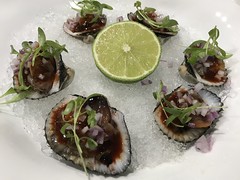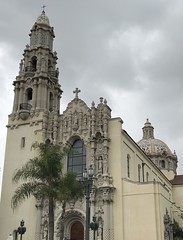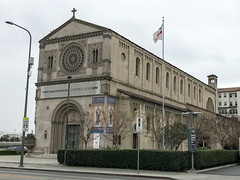Today was my first encounter with the legendary foodie cluster near USC called the Mercado La Paloma. Lots of good choices to try, but I zeroed in on Holbox, a mariscos bar serving some amazing fresh shellfish and fish. This is what Jiro might have dreamt of if he grew up in San Felipe instead of Tokyo. The place is arranged like a sushi bar, with patrons sitting around three sides of the prep area watching the master ceviche makers at work. I had a yellowtail ceviche tostada with avocado below and chile morita salsa on top, wonderfully fresh and the lime and salsa just make it pop. Then I treated myself to a half dozen patas de mula or "blood clams", dark bivalves with a shell containing hemoglobin. Until a few years ago, their import had been prohibited and you could only find them in Baja California. With minced onion, salsa, and fresh herbs, these were mouth-pleasing flavor bombs.
After lunch, I wandered in search of a couple of landmark churches I'd been wanting to visit. Strolling past the Galen Center, with its brick relief murals of sports figures, the classic Automobile Club building, and the classic mid-century Felix Chevrolet neon sign, I came to the St. Vincent de Paul church, facing diagonally to the corner of Figueroa and Adams. It's quite visible from the 110 freeway, and I've often admired it on my commute. It was dedicated in 1925, designed by noted architect Albert C. Martin (who also designed LA City Hall and the Million Dollar Theater building), and largely financed by oilman Edward Doheny whose mansion was nearby. The architectural style is called Churrigueresque, a very ornate Spanish Baroque style originally popular in the early 1700s, and notably revived in the buildings for the 1915 Exposition in Balboa Park, San Diego. The church's intricate plaster ornamentation and multicolored tile domes are striking. Entering through the oversized dark wood doors, one finds the interior is every bit as grand as the exterior. The vaulted cathedral-like space is lined with light-colored stone (travertine?), with rounded arches and dark wood exposed beam rafters. An impressively ornate guilded reredos lies in front, with richly carved wood altars in the side chapels. If you want someplace solemn to light a candle (and I did want that today), this is the place.
After spending time appreciating the beauty of this sacred space, I wandered just a block up Adams to see how St. John's, the Episcopal Cathedral of Los Angeles, would compare. Also built in 1925, and also grand in its way, though more restrained in its Romanesque Revival style. Its basic structure is more rectangular and austere, though it has some lovely ornamentation etched into its stone. A banner declares it a "house of prayer for all people", though apparently not at all days or hours, as, unlike the Catholic church, it did not appear to be open on a Friday afternoon. I'll have to find another time to discover what the interior looks like.
(See full album of photos from this day.)
Friday, January 19, 2018
Subscribe to:
Post Comments (Atom)




No comments:
Post a Comment